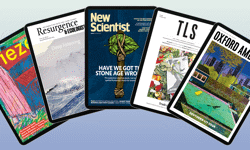
Sharon Cooper, chief digital officer at The Economist Intelligence Unit, cites a popular YouTube sequence showing young men in Saudi Arabia driving cars using only two wheels as a colourful metaphor for the challenges she faces in her current role. But it could just as well be applied to any publisher grappling with managing today’s digital needs while simultaneously planning for tomorrow’s requirements.
“It’s the most amazing piece of footage,” she observes. “And it’s what I’m trying to do – like changing the tyre while the car is driving along.”
When it comes to meeting this challenge, Cooper’s digital transformation experience – her CV includes almost six years at BMJ, latterly as CDO; four years as director of product strategy & innovation at the Cabinet Office followed by a year at the Government Digital Service as deputy director, government & agency transformation; and running her own digital delivery consultancy – makes her better-positioned than many. Which is just as well. As she is now working at a publisher firmly positioned at information content’s cutting edge.
The Economist Intelligence Unit (EIU) is a business providing forecasting and advisory services through research and analysis, such as monthly country reports and multi-year country economic forecasts, that sits within the Economist Group – publisher of The Economist.
Its 270 analysts and contributors covering 205 countries spend an average of 5,000 man hours each week on country, industry and risk analysis. Their outputs span a wide range of special reports, global forecasts, latest thinking and newsletters and services that range from subscription products through consultancy solutions to global advisory and an economist corporate network.
To put EIU in its business context, in the year to March 2018, it contributed revenues of £60m to group revenues of £367m while The Economist Businesses, in which The Economist newspaper sits alongside related activities such as events and digital products, contributed £262m.
Though revenue and profit slipped at EIU over the same year, EIU’s country report core was described in that year’s annual report as “solid”. Renewal rates among subscribers was boosted to 94%, meanwhile, with predictions for the current year said to be “more promising” than twelve months before. And progress made improving market position and sales efficiency was deemed as “good”.
That opportunity to learn something new was a big part of my decision-making.
Lots to do
Against this backdrop, Cooper arrived in August 2018 from BMJ.
“What appealed most was they approached me and said: ‘We need to do a lot of things’,” she says. Why? Well for a start, the position of CDO had been unfilled for a while.
“Then there was the fact that they were much more of a data-driven organisation (than the BMJ) given that what they were using to create the content – their economic forecasts and so on – was data. And that was an area I’d not had much experience of but wanted to get into in more detail. That opportunity to learn something new was a big part of my decision-making.”
At BMJ, Cooper’s responsibilities were broad, including overseeing the development of professional, data-driven digital products as well as managing corporate IT, GDPR and cyber security. At EIU, her brief is narrower but profound: to simultaneously optimise legacy technologies while putting in place a framework for the business’s future digital technology needs as it works to keep pace with its customers’ ever-changing requirements and expectations.
“Like a lot of organisations, there was much legacy technology in the business when I arrived – things that while working well, won’t enable you to change and grow,” she says. “A lot of the underlying structure is (still) driven by the print to digital transformation – an evolution which has already happened and must now change again.”
It’s about having the ability to slice and dice information in many different ways.
Evolving client needs
An important next big challenge is to cater for clients who increasingly demand more than an opportunity simply to read what EIU thinks about a single country in isolation.
“Take China, where the countries it is investing in as part of its belt and road initiative (a global investment strategy involving investments in 150+ countries) are not bound by geography,” says Cooper.
EIU’s structure is, in some ways, still set by geography, she explains. So, changes are needed to how it approaches creating products that unite information from many different countries, not those immediate neighbours, and what it can do at a micro level.
“Should I put a new store in this or that part of Shanghai? Do I want to invest in this particular business in that particular part of Chile? What is the political climate there today, how is it likely to change over the next three to five years, and how should that change my investment decisions?” she continues.
“These are the kinds of questions our information must help our clients answer.”
The solution lies at a number of different levels.
“Part of it comes down to how you hold the information and data and then update and process it. The world is changing. Globalisation means that what happens in one part of the world has a ripple effect on lots of others and that changes far more quickly than it did in the past, so it’s about having the ability to slice and dice information in many different ways,” she explains.
But it’s also about responsiveness, and that’s not just in terms of speed but also meeting customers’ growing demand not just to read what EIU analysts think but, increasingly, to talk to them.
“These days, it’s far more about dialogue than broadcast,” Cooper continues. “And the demand is for tailored information, access, and flexibility so they can take our content into their own work systems.”
Since her arrival, the focus has been on reviewing every aspect of what the business needs to function today while assessing its likely future requirements – and the most appropriate ways of meeting them.
The demand is for tailored information, access, and flexibility so they can take our content into their own work systems.
What to do first
“Almost everything could change and be replaced in terms of legacy infrastructure,” she explains.
“But when you can’t afford to do it all in one go, you change what needs changing most urgently and what’s going to deliver great value to the business, with emphasis on those things that are most client-facing.”
Describing this as still work in progress, she adds: “We have two different sets of customer needs: internal customers who need tools fit for purpose, and eternal customers who care less about how we do what we want to do and most about our ability to optimise the delivery of content at the moment they most need it.”
Already clear is that one priority should be to free up EIU analysts’ time where possible so they can focus on activities that deliver greatest value. And to this end, EIU has been experimenting with automated content creation.
“We’re doing a lot of testing, writing the rules the algorithms follow to automate writing certain basic content and understanding the principles of ethical AI and avoiding algorithmic bias,” Cooper explains. “In one sense, publishing is the easy bit. The bigger challenge lies in quality assurance.”
EIU prides itself on the accuracy of its content – in May, EIU topped the list of the world’s most accurate forecasters with 39 first place rankings at the 2019 Analyst Forecast Awards in Barcelona, and accuracy is a big part of its brand value. To ensure this, it has a process of second checking, so every analyst’s work is checked by another to ensure it is consistent and nothing it says is a single, lone view.
“How an automated piece of content is flowed in without conflicting with anything else we have said is critical,” Cooper continues.
“But also important is the fact that customers can get a lot of our data from other sources – GDP figures, for example. It’s what we say about those figures that’s the difference. So, authority and tone of voice are also key.”
It’s a tricky area, then. And as a result, only when EIU is totally happy with the tone of the automated content it creates, will it be released.
How an automated piece of content is flowed in without conflicting with anything else we have said is critical.
New data tools
Other new technologies Cooper is actively exploring include augmented reality for modelling and data visualisation.
“We are starting to work out how instead of supplying clients with flat tables and charts, we put more tools into their hands so they can play around with the data we supply and do so with the confidence it won’t clash with other content, crash or give an inaccurate picture,” she says.
“We are also working increasingly with third party data providers experimenting with more real-time data to create new products.”
A recently-launched example of such a product is a tool with combines real-time satellite data feeds about crude oil tankers – where they are in the world, how much oil they are carrying and to where, when – with EIU commodity data to predict oil prices not just today or tomorrow but up to a number of years ahead.
Moving forward, Cooper believes key opportunities for EIU lie in delivering against demands for content to be provided in ways that mean it can be used more flexibly, for inter-related data to be more readily accessible and closely integrated, and for EIU content to be more deeply embedded in its customers’ workflows.
Inevitably, if EIU is to serve its clients more flexibly and personally, it will need to hold more client data so it will also have to evolve its approach to managing that effectively and securely.
In the future, she expects there to be closer integration between EIU’s consultancy and product offerings and a greater emphasis on semantic tagging – how the metadata underlying any piece of content can be optimised for EIU’s growing number of clients who use machine reading to integrate EIU content into their own workflows.
EIU could be a very different organisation in five years’ time, Cooper predicts.
“There are clients who say: ‘Just tell me, I need to know the answer to a question’ – and that’s almost where we are right now,” she observes.
“Then there are those wanting more tailored and bespoke solutions, requiring further integration of our consulting and more traditional written outputs which will make us a more data-driven, more data-rich, organisation. Meanwhile, desire for more frequently changing content with real-time forecasting, real-time dashboarding, is also growing.”
EIU’s aim is to optimise for all these needs – a job with no fixed end point, so it will therefore be ongoing.
“With the world changing ever-faster, our predictions and our modelling and how frequently they should change are all important questions for us to answer,” Cooper adds.
So too is how best to strike a balance between EIU’s long-term forecasting and other content, which should change much less frequently, and ‘nowcasting’ which should change quite rapidly.
“How to do this and make sure there is a cohesive story between the two is not something I can answer yet,” she admits. “But it will be a very interesting place to be.”
This article was first published in InPublishing magazine. If you would like to be added to the free mailing list, please register here.










